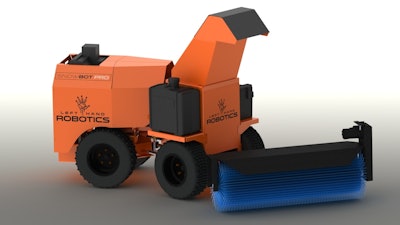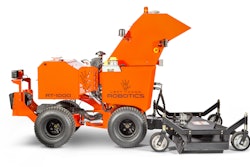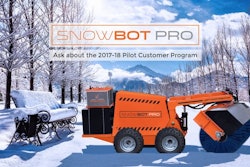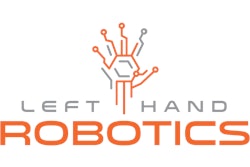
Left Hand Robotics has developed a commercial-class, self-driving snow clearing robot for use on sidewalks and walkways. Mike Ott, CTO of Left Hand Robotics, says the idea for the machine came about due to frustration with snow removal services in Colorado, where the company is based.
He says the initial idea was to create a residential, personal use machine. However, upon further market research, he and his partner discovered there was a need for such a machine in commercial applications for use by snow and ice management professionals. “Snow and ice management companies, property managers, government agencies, etc. all face significant labor challenges when it comes to sidewalk and pathway work in the winter,” he explains. “Securing the necessary labor force on short notice, in harsh conditions, for strenuous, dangerous snow removal work is very difficult.
“Companies are frequently forced to pay high wages to get workers on site, if they can get them at all,” he continues. “During prolonged snow events, these workers tire and can make mistakes, exposing the company to costly [claims and potential downtime issues].”
And so in 2016, Ott and his business partner Terry Olkin founded Left Hand Robotics to create their autonomous snow removal machine, the SnowBot Pro. It works by following a programmed path using GPS, accelerometer and gyroscope technologies, and can be remotely controlled via an online dashboard.
The SnowBot Pro uses a 4 ft. (1.2 m) wide rotating brush for snow removal, and according to the company, can reduce the number of people needed for shoveling or operating a snow blower by up to 80%.
Enabling autonomous operation
Unlike many autonomous vehicle applications which still require the presence of an operator, the SnowBot Pro does not. It is designed to both navigate and accurately detect unexpected obstacles, says Ott. The residential-class autonomous mowing robots available on the market today, for instance, almost exclusively rely on buried boundary wires, he says, to define their area of operation and often mow in random, 'bounce-around' patterns. Meanwhile, the SnowBot Pro exclusively follows a defined path.
Ott says that while automatically being able to determine an 'avoidance routine' that would let the machine get back to clearing its assigned path might still be some time down the road, sending an alert to the person responsible for the site and allowing them to assist remotely is still a huge benefit to companies, especially when trying to clear several sites in parallel during a big snow event. “Our expectation is that a single person could sit in a snow removal company’s operations center monitoring and directing dozens, or even hundreds, of SnowBots operating simultaneously on their customer sites,” he says.
High-precision GPS RTK technology is utilized to navigate the SnowBot Pro without a human operator. To establish its path, Ott says contractors 'record' the sidewalks and pathways the machine will be operated on during the off season with a special tool provided by Left Hand Robotics. The recorded paths are then uploaded to Left Hand Robotics’ cloud-based operations center and compiled by its proprietary path generation software. This information is turned into a set of commands used to drive the machine.
Ott says multiple redundant technologies are currently being tested on the machine to perform obstacle detection. “We use one or more of radar, lidar, ultrasonic and infrared technology to identify obstacles in the path,” he explains. “The exact combination of the technologies used will depend on the [weather] conditions as some of these sensors perform better than others in certain conditions.”
According to Ott, the SnowBot Pro’s cloud connectivity and IoT (Internet of Things) capabilities are core to its operation. The machine is connected to the Cloud at all times when in operation, enabling it to stay on site and be at the ready once the next snow or ice event occurs. “By remaining connected to our operations center, the robot can be remotely activated for pre‐treating, snow clearing, or post‐treating duties,” he says. “Our customers can activate and monitor their robots via a web application that runs on any internet‐connected device.”
During operation, the SnowBot Pro is continuously capturing job performance data, including before and after pictures of the work site, which is uploaded to the Left Hand Robotics Operations Center. Ott says this data is then made available to machine owners to help support their business, as well as protect them in case of any customer disputes.
The Cloud connection is also used to send alerts, including pictures, in the event of an unexpected obstacle getting in the machine’s way, or other performance issues occurring, such as low fuel level. When owners receive these alerts, they can remotely instruct the SnowBot Pro how to proceed. “All of this performance data is also being continuously monitored at our Left Hand Robotics Operations Center which can also help out as needed,” says Ott.
As self-driving vehicles are complex, Ott says there are many challenges associated with developing them, such as achieving centimeter-level accuracy in navigation. One of the most difficult for the Left Hand Robotics team is ensuring accurate obstacle detection in blizzard conditions while simultaneously blowing snow up in front of the machine. Using the correct sensor technology will be key to overcoming this; the company is still testing a full array of available sensor technologies, says Ott, to determine the exact combination of sensors that will provide the best detection at a feasible price point.
Ott says this problem is further complicated by the fact snow doesn’t fall every day, making it difficult to continuously test the machine. “Furthermore, even when the snow does fall, the rate and consistency of every snow storm is different, so ensuring we have a robust obstacle detection solution is no easy task,” he notes.
Another difficulty is cost. Incorporating commercial-class quality and robustness into a machine, while achieving the company’s target price point, is challenging as sensor technology can be expensive. “Autonomous machines require sensor feedback on almost every moving part, and operating in the harsh environment of the North American winters requires robust (i.e. expensive) sensor technology,” says Ott. “Autonomous mining vehicles, as an example, use many of the same technologies but have a price point as much as 10 times higher than our target.”
He says packaged sensor solutions are available from many vendors, but are typically above Left Hand Robotics’ price target. “Frequently, the high price point of these solutions is tied to included features that our machine simply doesn’t need,” he says. Instead, the company is aiming to start with a basic sensor and then build up the rest of the sensor system itself and only include the features it deems important.
Technology improvements are occurring daily, which Ott says can be a challenge to keep up with, as well. “With giants like Google, Caterpillar and Tesla trying to solve many of the same problems we’re facing, there’s sure to be no end to the technology improvements coming at us.”
Hydraulically driven for reliability and familiarity
The SnowBot Pro is powered by a Vanguard 28 hp EFI V-Twin gasoline engine—instead of a battery like the mowing robots—which drives tandem hydraulic pumps. The two hydraulic pumps are a variable-displacement, closed loop piston pump used to power the drivetrain, and an open loop gear pump used to actuate cylinders for steering, lift, pivot, as well as spin the rotary broom. Ott notes that hydraulic power is generally considered more robust, particularly in snow and ice conditions, than using various belts to control machine functions.
He says gasoline power is preferred to battery technology in such an application because the machine can stay on the job longer as it does not require periodic downtime for recharging or battery swapping. “The SnowBot can work for days at a time while only pausing long enough to refill the fuel tank,” he says. “This is important during multi-day snow events common in North America.”
In addition, batteries don’t currently perform well in cold weather. Because the machine is intended to sit outdoors at a customer site, the battery would require continuous charging to be ready to perform once a snow event occurs, Ott says. He also notes that electric vehicle technology is more expensive; while this is changing, it will be some time yet before an electrically powered machine is cheaper than a fossil-fuel driven one.  An overhead view of the SnowBot Pro.Left Hand Robotics
An overhead view of the SnowBot Pro.Left Hand Robotics
Gasoline, hydraulic powered equipment is familiar to customers, as well. “Most of our target customers perform their own fleet maintenance so performing normal maintenance on these machines will be easy for them,” says Ott. “Introducing electric vehicle technology on top of the self-driving technology would likely not be well-received by our target customers.”
The SnowBot Pro features four-wheel drive, and is center articulating with 5 in. (127 mm) of ground clearance and over 6 in. (152.4 mm) of frame oscillation between the front and rear sections. Four independent hydraulic wheel motors work together with a limited-slip hydraulic drive circuit to maximize performance in adverse conditions, says Ott. Spinning and articulation of the rotary boom is hydraulically controlled, as well. Once released commercially, he says the machine will have the ability to be equipped with either a liquid or solid deicer attachment, and various broom widths will be available.
Left Hand Robotics is preparing to conduct a SnowBot Pro Pilot Customer Program during the 2017-2018 winter season. It will be used by actual snow management companies at their customer sites to assess performance of the machines and the supporting software systems. Ott says once this pilot program is completed, the company will begin accepting orders for the machine to be delivered in time for the 2018-2019 winter season.




















